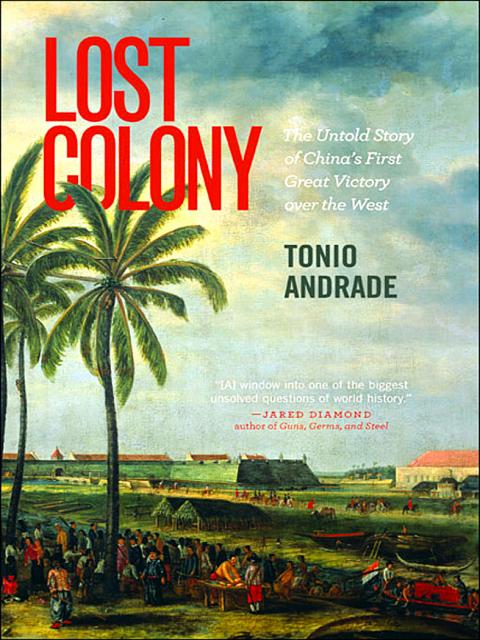Tonio Andrade is a well-known and respected figure in the small world of Taiwan history experts. His earlier work, How Taiwan Became Chinese, was well researched and documented, although I disagreed with his overall thesis.
History repeats itself with this new book. It is well written and could easily pass for an exciting historical novel. Andrade spins a gripping tale, full of excellent anecdotes and insights, but then goes off on a tangent when drawing his conclusions.
Andrade’s main thesis is that, contrary to conventional wisdom, Ming follower Zheng Chenggong (鄭成功, also known as Koxinga), was able to defeat the Dutch settlement of Fort Zeelandia (present-day Tainan) in 1661-1662 due to a relative equal level of gun technology (both big guns and smaller handguns) and superior military tactics and strategy.

He does detail how the Dutch maintained an advantage in terms of having a highly defensible fortress (renaissance fort technology) and the ability of their ships, loaded with heavy guns, to maneuver fast in deep water, with sail rigging that enabled them to sail into the wind.
However, these advantages were, in Andrade’s view, not sufficient to make a difference in the conflict, particularly due to some basic errors made by Frederick Coyet, the Dutch commander of the fort. In particular Coyet had not taken advantage of opportunities to build bridges and alliances, both with the Dutch East India Company and with the Manchu/Qing rulers who came to power in China after 1644.
Coyet was actually a Swedish nobleman in Dutch service. He was a proud and principled man, and had his differences with officials in Batavia, as well as with key commanders of the fleet that was sent to break Koxinga’s blockade, which lasted from April 1661 to February 1662.
LOSS OF TAIWAN
After the “loss of Taiwan,” Coyet returned to Batavia, was tried for treason and almost executed (described in detail by Andrade in the first chapter), but was then banned to a far-away island. After 10 years he was released, returned to the Netherlands, and wrote a stinging rebuke of his superiors in Batavia, titled “’t Verwaerloosde Formosa” (The Neglected Formosa), which became a best seller.
Andrade writes that Koxinga was able to incorporate new ideas and technologies. He was the son of a Chinese pirate father, Zheng Zhilong (鄭芝龍), and a Japanese mother, Tagawa. Born in Nagasaki in 1624, at age seven his father moved him to China where he continued his schooling and eventually studied at Nanking University. When the Qing dynasty took over in 1644, his father surrendered, but the son continued resistance along the coast.
From 1658 to 1659 he assembled a large fleet, sailed to the North, and tried to recapture Nanking, but was beaten back by Qing forces (and by a typhoon which wrecked many boats and drowned many of his men). During the following year, he was under increasing pressure from Qing forces, which pursued him down the coast. Eventually, in early 1661, he assembled some 400 boats and 25,000 men and crossed the Taiwan Strait to lay siege to the Dutch settlement at Anping (present-day Tainan).
Because of information gleaned from a defector named He Bin (a translator who had provided him with maps of the fortress), Koxinga was able enter the bay behind the fortress through a narrow channel and land his fleet outside the reach of the big Dutch cannons in the fortress. He attacked and took the smaller Fort Provintia (in today’s Tainan) and thus cut off supplies both on land and sea. This started a siege that would last nine months.
Miraculously, the Dutch were able to send word of the siege to Batavia. In one of the major daring feats of the episode, a small yacht named Maria under captain Cornelius Clawson was able to sail against the prevailing monsoon winds and make it to the VOC headquarters in seven weeks. A relief fleet under commander Jacob Cauw was sent and had a speedy journey back to Taiwan, but the counterattack against Koxinga failed, partially due to a typhoon and partially due to disagreements between Cauw and Coyet.
As the siege continued, supplies in the fort began to run out, while Koxinga was also aided by another defector, Hans Radis, a German sergeant who had been in Dutch service and who loved rice wine, which Koxinga gave him plenty of. Radis gave Koxinga inside information on the defense of the fortress.
FREE PASSAGE
The situation eventually prompted negotiations in which Coyet was able to ensure free passage for himself and other Dutch at the fortress. In total some 630 Dutch and 9,000 Chinese combatants were killed, in addition to several thousand Aboriginals, fighting on the side of the Dutch. In addition, Koxinga killed several hundred Dutch missionaries and teachers in surrounding villages.
However, the story doesn’t end with the fall of Zeelandia. Andrade writes that the fighting continued across a broad front from 1662 to 1668. In 1663, Dutch admiral Balthasar Bort coordinated with a Qing Dynasty fleet and defeated Koxinga’s remaining forces on Kinmen. In 1666, the Dutch had built up a fortress in the northern port city of Keelung, and, with only 300 defenders, fended off an attack by some 40 junks and 3,000 Koxinga troops. Koxinga himself had of course died in 1663, but his successors held out until 1683, when they were defeated in the Battle of Penghu by Qing admiral Shi Lang (施琅).
While Andrade’s thesis states that technology, strategy and tactics, appropriate alliances, and even the weather helped to determine the battle’s outcome, two other factors did make a more significant difference in the conflict around Zeelandia: distance and overwhelming force. Taiwan was a long distance from Batavia (several weeks of sailing) and very close to the Chinese coast. Koxinga could thus bring in large numbers of troops, reinforcements and ships within a short period of time, while the Dutch had to travel large distances.
Another incorrect conclusion by Andrade is to call this a victory by “China” over the West. At that point, 1661 to 1662, Koxinga was not representing China at all, but his own personal fiefdom along the Coast. He kept the Ming Dynasty pipedream alive in order to keep a following among the adherents of the defeated dynasty. He was a renegade on the run from Beijing. In fact, Qing rulers were trying very hard to eradicate his strongholds along the coast, and that is why he took refuge across the Strait, trying to get away from China.
These quibbles aside, Lost Colony is well written with a wealth of details that are well documented.
Gerrit van der Wees is editor of Taiwan Communique, a publication where this review first appeared.

June 9 to June 15 A photo of two men riding trendy high-wheel Penny-Farthing bicycles past a Qing Dynasty gate aptly captures the essence of Taipei in 1897 — a newly colonized city on the cusp of great change. The Japanese began making significant modifications to the cityscape in 1899, tearing down Qing-era structures, widening boulevards and installing Western-style infrastructure and buildings. The photographer, Minosuke Imamura, only spent a year in Taiwan as a cartographer for the governor-general’s office, but he left behind a treasure trove of 130 images showing life at the onset of Japanese rule, spanning July 1897 to

In an interview posted online by United Daily News (UDN) on May 26, current Chinese Nationalist Party (KMT) Chairman Eric Chu (朱立倫) was asked about Taichung Mayor Lu Shiow-yen (盧秀燕) replacing him as party chair. Though not yet officially running, by the customs of Taiwan politics, Lu has been signalling she is both running for party chair and to be the party’s 2028 presidential candidate. She told an international media outlet that she was considering a run. She also gave a speech in Keelung on national priorities and foreign affairs. For details, see the May 23 edition of this column,

The Taiwan People’s Party (TPP) on May 18 held a rally in Taichung to mark the anniversary of President William Lai’s (賴清德) inauguration on May 20. The title of the rally could be loosely translated to “May 18 recall fraudulent goods” (518退貨ㄌㄨㄚˋ!). Unlike in English, where the terms are the same, “recall” (退貨) in this context refers to product recalls due to damaged, defective or fraudulent merchandise, not the political recalls (罷免) currently dominating the headlines. I attended the rally to determine if the impression was correct that the TPP under party Chairman Huang Kuo-Chang (黃國昌) had little of a

At Computex 2025, Nvidia CEO Jensen Huang (黃仁勳) urged the government to subsidize AI. “All schools in Taiwan must integrate AI into their curricula,” he declared. A few months earlier, he said, “If I were a student today, I’d immediately start using tools like ChatGPT, Gemini Pro and Grok to learn, write and accelerate my thinking.” Huang sees the AI-bullet train leaving the station. And as one of its drivers, he’s worried about youth not getting on board — bad for their careers, and bad for his workforce. As a semiconductor supply-chain powerhouse and AI hub wannabe, Taiwan is seeing